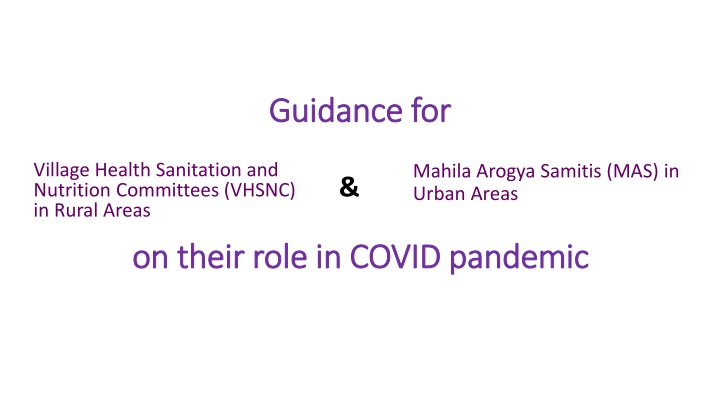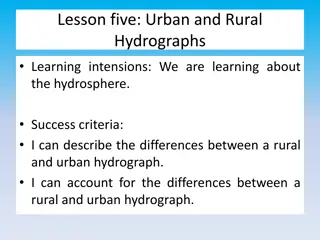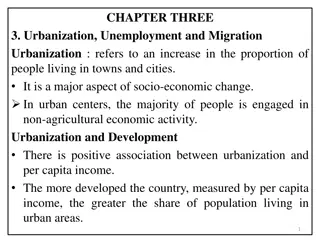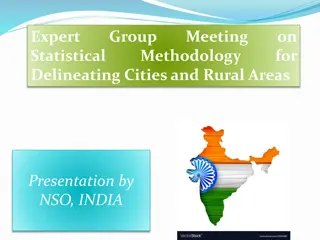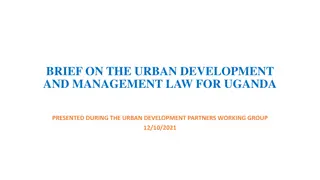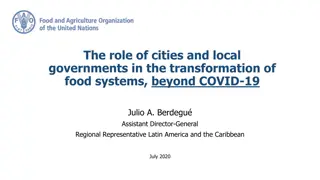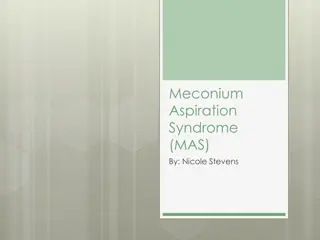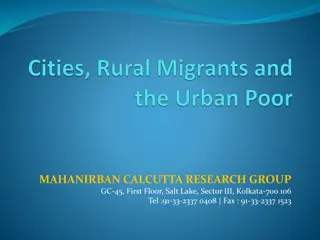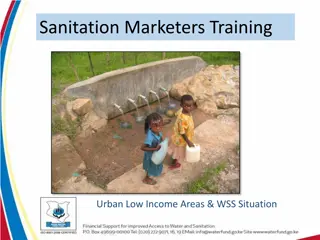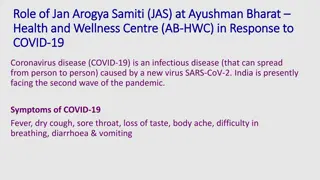Role of VHSNC/MAS in Preventing Spread of COVID-19 in Rural and Urban Areas
Explore the vital role of Village Health Sanitation and Nutrition Committees (VHSNC) in rural areas and Mahila Arogya Samitis (MAS) in urban areas in combating COVID-19. Learn about their responsibilities, such as identifying nodal persons for COVID response, raising awareness, facilitating community dialogue, and promoting COVID-appropriate behaviors. Discover the various strategies they employ to prevent the spread of the virus and support their communities during the pandemic.
Uploaded on Sep 12, 2024 | 2 Views
Download Presentation

Please find below an Image/Link to download the presentation.
The content on the website is provided AS IS for your information and personal use only. It may not be sold, licensed, or shared on other websites without obtaining consent from the author.If you encounter any issues during the download, it is possible that the publisher has removed the file from their server.
You are allowed to download the files provided on this website for personal or commercial use, subject to the condition that they are used lawfully. All files are the property of their respective owners.
The content on the website is provided AS IS for your information and personal use only. It may not be sold, licensed, or shared on other websites without obtaining consent from the author.
E N D
Presentation Transcript
Guidance for Guidance for Village Health Sanitation and Nutrition Committees (VHSNC) in Rural Areas Mahila Arogya Samitis (MAS) in Urban Areas & on their role in COVID pandemic on their role in COVID pandemic
Role of Village Health Sanitation and Nutrition Committee (VHSNC)/ Mahila Arogya Samitis (MAS) in Response to COVID-19 Coronavirus disease (COVID-19) is an infectious disease (that can spread from person to person) caused by a new virus SARS-CoV-2. India is presently facing the second wave of the pandemic. Symptoms of COVID-19 Fever, dry cough, sore throat, loss of taste, body ache, difficulty in breathing, diarrhea & vomiting
Preventing the spread of COVID 19 Physical distancing of 2 Gaj (6 feet) with others Always wear face mask, cover nose & mouth properly Avoid going to crowded places Wash hands with soap for 40 seconds, incase hands are not visibly dirty rub an alcohol-based sanitizer for 20 seconds Follow cough and sneeze hygiene Avoid handshake Get 2 doses of vaccine as per the protocol Avoid touching nose, mouth, ears or mask Those who are ill self- isolate
What is the role of VHSNC / MAS in preventing spread of COVID-19? Identify a nodal person for COVID response among VHSNC/MAS members Build awareness using information boards, miking/announcements, video/audio messages, folk theatre, bhajan mandalis, social media etc. Engage SHGs and other CBOs to form teams of community volunteers to participate in COVID-19 response activities Conduct regular cleaning and disinfection of frequently used public places Keep vigilance on migrants for symptoms and providing them support Discourage public gatherings and social events Monitor practicing of physical distancing and mask use at public places with help of Gram Panchayat/urban local body Ensure that local and state COVID helpline numbers are available to public
Continued What is the role of VHSNC/MAS in preventing spread of COVID-19? Initiate and encourage community dialogue against stigma and discrimination Promote COVID appropriate behaviours and adoption of hygiene practices Engage in community dialogue for imposing and adherence to lockdowns Engage community volunteers to support management of lockdown and ensure supply of essential commodities Review and regulate gatherings like markets etc. Promote virtual platforms for socializing Motivate community to encourage home isolation with teleconsultation support as preferred treatment option for those who do not need hospitalisation. Reading material on various aspects of COVID management, home isolation & IEC have been given in the next 2 boxes
What role can VHSNC/MAS play in early identification and screening? Support ASHAs for regular community surveillance for influenza like illness/severe acute respiratory infections (ILI/SARI) Support ASHAs/MPWs in timely linking of symptomatic cases with CHO/MO for testing and identification Depending upon the number of cases, conduct contact tracing as per Integrated Disease Surveillance Programme Protocol (IDSP Contact tracing: https://www.ncdc.gov.in/showfile.php?lid=570)
Home isolation is separation of people infected with COVID-19 or those having COVID like symptoms even if not tested for COVID-19 What is Home What is Home Isolation? Isolation? Those who are in home-isolation stay at home until it is safe for them to be around others. At home, they separate from others, stay in a separate room, and are provided tele consultation facilities.
Organise home isolation facilities in schools, religious places etc. for those with no place for self isolation Coordinate with ASHA & Health and Wellness Centre team to organise teleconsultation services for those in home isolation Utilize untied funds for providing mask, gloves and sanitizers for the infected individuals and their families Identify local solutions for home delivery of essential items and services to self isolated families Promote alternate ways of socializing to help those in home isolation cope with mental stress Take steps to arrange transportation for those who need facility referrals Identify referral facilities/Helpline number and nodal persons for hospital beds How can How can VHSNC/MAS VHSNC/MAS support in support in home home isolation? isolation?
Purchase pulse oximeters and thermometers at the village level from the untied fund/community/other contributions How can How can VHSNC/MAS VHSNC/MAS support in support in home home isolation? isolation? Make arrangement for loaning out of pulse oximeters and thermometers to the families under home isolation Arrange distribution of home isolation kits through frontline workers
What role can VHSNC/MAS play in establishing COVID Care Centre (CCC) Identify - schools, community halls, marriage halls, panchayat/municipal buildings, tentage facilities in the area in close to PHC/SHC for establishment of 30-bedded COVID Care Centre, as per the guidelines. Ensure - adequate space, physical distancing, room ventilation, drinking water, toilet etc. are available at the COVID Care Centre Ensure - availability of Basic Life Support Ambulance (BLSA) equipped with 24x7 oxygen support for transportation of critical cases to Higher Centre Conduct- periodic review and upkeep of the CCCs(a checklist to be used by VHSNCs/MAS is given in the next slide)
Checklist for review of COVID Care Centre (CCC) Physical distancing between beds (at-least 1 meter between beds) Provision of drinking water and toilets Separation between suspected and confirmed cases Adequate natural ventilation in rooms. Putting up exhaust fans if possible. Regular cleaning and sanitization of CCC as recommended Adherence to physical distancing by care givers and family members Adequate provision of nutritious food as recommended by health providers 24*7 availability of basic life support ambulance with oxygen support
Conduct awareness generation in the community through Frontline Workers and community volunteers Mobilise support from opinion leaders and community groups for vaccination How can VHSNC / How can VHSNC / MAS support MAS support people to be people to be vaccinated for vaccinated for COVID COVID- -19? 19? Support families in getting registered for vaccination Provide and publicize information about the nearest vaccination centres Motivate for adherence to COVID appropriate protocols after vaccination
In collaboration with the PRIs/urban local bodies ensure availability of hand wash facilities in schools, marketplaces and other public places; water availability, toilets for home isolated Support ASHA and the Ayushman Bharath-Health and Wellness Center (AB-HWC) team in routine health services, organising Village Health and Nutrition Day (VHND)/Urban Health and Nutrition Day (UHND) and ensure continued care of pregnant and lactating women people with long term health problems elderly people with disabilities and people with terminally ill conditions Work with Gram Panchayat/Urban local bodies for continuation of MNREGA and other permitted labour esp. for migrant families Role of VHSNC / Role of VHSNC / MAS to support MAS to support continued access continued access to essential to essential services services Support FLWs in organizing emergency transport for patients needing emergency healthcare
IEC Material available on Government sources COVID-19 Communication: https://drive.google.com/drive/folders/1WwRf- H_mQu0XY8nnNgUd3byP9mchGQdH COVID Vaccination: https://drive.google.com/drive/folders/1Y6eQohnz8- y1M9YDqqhIDPnrZdQMByQJ?usp=sharing Jan Andolan October 2020: https://drive.google.com/drive/folders/1P4lwQUEYDHVXPfUHbkJ1Qct_y0lJQAsg State IEC & AVs: https://drive.google.com/drive/folders/1kXHt1zGECH5RN49mbDILNcd_OWee8USH?usp=sharing Vaccine Hesitancy Digital Pack: https://drive.google.com/drive/folders/1bXkzSNRKF8- 4KTAkYXA0J7sfVUR1e_Fm?usp=sharing Protective gear: https://drive.google.com/drive/folders/1EGFcE- 8vyNfcc_uLsP85MOGFShZa_cdb?usp=sharing Jan Andolan April 2021: https://drive.google.com/drive/folders/1exD3siPrPTV4QqZifnZP07XuBlGDunUr?usp=sharing
Reading material Reading material (can be shared in social media or given as handouts to the people by VHSNC/MAS) (can be shared in social media or given as handouts to the people by VHSNC/MAS) FAQs on COVID-19 Vaccines for Health workers, Frontline workers and General Public by MOHFW https://www.mohfw.gov.in/pdf/FAQsforHCWs&FLWs.pdf) https://www.mohfw.gov.in/pdf/FrequentlyAskedQuestionsonCOVID19vaccineGeneralPublicEnglish.pdf Revised Guidelines on Home Isolation of Mild/Asymptomatic COVID-19 Cases by MOHFW https://www.mohfw.gov.in/pdf/RevisedguidelinesforHomeIsolationofmildasymptomaticCOVID19cases.pdf Encouraging Youth to Advocate Against Stigma and Discrimination by MOHFW https://www.mohfw.gov.in/pdf/EncouragingYouthtoadvocateagainstS&DduringCOVID19EnglishToolkit_final.p df COVID-19 Proning for Self Care by MOHFW https://www.mohfw.gov.in/pdf/COVID19ProningforSelfcare3.pdf SOP for Preventing Spread in Religious and Public Places: MOHFW https://www.mohfw.gov.in/pdf/SOPonpreventivemeasurestocontainspreadofCOVID19inreligiousplacesandpla cesofworship.pdf IDSP Contact tracing: https://www.ncdc.gov.in/showfile.php?lid=570 SOP on COVID-19 Containment and management in periurban, rural and tribal area https://www.mohfw.gov.in/pdf/SOPonCOVID19Containment&ManagementinPeriurbanRural&tribalareas.pdf
